The Advantage Goes to Chinese Militarists
- Share via
There was nothing accidental about the April 1 collision of the People’s Liberation Army F-8 jet fighter with the U.S. Navy’s EP-3 electronic intelligence aircraft. It happened because of deliberate military decisions that were not specifically authorized by the civilian leaders of either side. It is bad enough to find that the era of Great Power rivalry did not end with the Cold War as many had hoped. It is even worse to discover that national policies can still now be so easily manipulated by military bureaucrats pursuing their own narrow aims.
Last year, at a time when the Clinton administration was in dissolution, leaving him without firm direction or control, Adm. Dennis Blair, commander in chief of all ground, naval and air forces in the Pacific, decided to intensify U.S. Navy EP-3 and U.S. Air Force RC-135 electronic intelligence patrols off the China coast. Judging by his speeches, Blair considers himself a notable strategist, and the reconnaissance flights were his response to Chinese threats against Taiwan, including the then new patrols by China’s heavyweight SU-27 jet fighters right up to the Taiwan coast.
The United States relies on satellite receivers to collect most of its normal, routine peacetime radar and radio signal intelligence. Manned aircraft collectors, both EP-3 turboprops and RC-135 jets are mostly useful to monitor exercises and maneuvers, when both radar and radio emitters move about, and in wartime of course, in preference to waiting for a satellite to pass overhead. In spite of rumors to the contrary, no Chinese forces were exercising on April 1 anywhere near the South China Sea.
The Chinese military, evidently right up to the minister of defense, Chi Haotian, reacted to the EP-3/RC-135 patrols by aggressively close intercepts. Pairs of Chinese F-8 jet fighters would be scrambled to reach the patrolling U.S. aircraft, then fly alongside them in very close proximity, to make the U.S. pilots “nervous.” The tactical aim was to intimidate the U.S. into flying farther away from Chinese territory, regardless of international law.
The strategic--or rather political--aim was to provoke exactly the sort of U.S.-Chinese confrontation that occurred, in order to secure more funding for the armed forces, as Defense Minister Chi has declared in an astonishingly frank statement: “We want to convert our indignation [over the loss of the F-8 and its pilot] . . . into a huge motivating force . . . to build a stronger military.”
During the week-and-a-half episode, every tool of propaganda was used to persuade the Chinese public to believe three impossibilities: that the U.S. Navy wanted to destroy the Chinese F-8, risking the lives of 24 of its personnel, doing so with a lumbering transport aircraft; that the greatest problem facing China today is not continuing poverty, life-threatening pollution or pervasive corruption but rather the U.S. refusal to acknowledge China’s right to intimidate Taiwan and its other neighbors; that China can both start a Cold War with the United States, and still continue on its export-led path to prosperity.
Once the EP-3’s crew is welcomed back, the decision to land the aircraft with its treasure trove of intelligence equipment on Chinese soil will no doubt be examined amid far larger questions. Will future patrols stay farther away from the coast, or will they be escorted? The first would be a surrender to Chinese pretensions; the latter a prescription for bloodier aerial encounters.
In the meantime, many will feel that the crisis has ended with at least a partial victory for the worst people in China--the military bureaucrats who care for nothing but increased budgets for the armed forces. If they prevail in Beijing, the tragic history of Chinese misgovernment will be resumed after a mere two decades of rationality.
More to Read
Sign up for Essential California
The most important California stories and recommendations in your inbox every morning.
You may occasionally receive promotional content from the Los Angeles Times.










